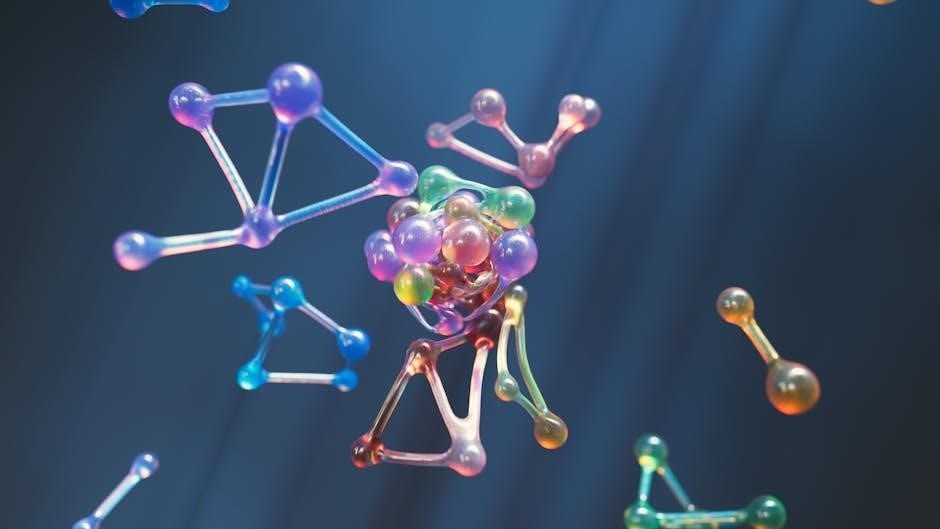Chemistry‚ the science exploring matter and its changes‚ is demystified in this comprehensive guide. It offers accessible insights into chemical principles‚ making it understandable for beginners. Explore core concepts easily.
What is Chemistry? Defining the Core Science
Chemistry‚ at its core‚ is the study of matter and its properties‚ along with how matter changes. It’s the science concerned with the composition‚ structure‚ properties‚ and reactions of substances. It delves into understanding the elements‚ compounds‚ and mixtures that constitute everything around us.
Chemistry seeks to describe matter‚ determine its characteristics‚ and explain why changes occur. This involves exploring atoms‚ molecules‚ and their interactions‚ forming the basis for understanding chemical reactions and transformations.
From a practical standpoint‚ chemistry provides insights into materials‚ their behavior‚ and their potential uses. It’s a fundamental science that bridges physics and other disciplines‚ offering a framework to comprehend the universe at a molecular level. Green chemistry principles‚ emphasizing sustainability‚ further shape the field.
In essence‚ chemistry is the science that explains the world by investigating matter and its transformations.
Why Study Chemistry? Relevance in Everyday Life
Studying chemistry unlocks a deeper understanding of the world around us‚ revealing its intricate workings at a molecular level. Chemistry explains the composition of everyday items‚ from the food we eat to the materials we use‚ providing insights into their properties and reactions.
Understanding chemical principles empowers us to make informed decisions about our health‚ diet‚ and the environment. It sheds light on the safety and effectiveness of medications‚ the nutritional value of foods‚ and the impact of pollutants.
Moreover‚ chemistry is essential for various industries‚ including medicine‚ agriculture‚ manufacturing‚ and environmental science. Its principles drive innovation in developing new materials‚ technologies‚ and solutions to global challenges.
By studying chemistry‚ we gain a valuable toolkit for critical thinking‚ problem-solving‚ and scientific literacy. It enables us to appreciate the beauty and complexity of the natural world‚ while also equipping us to address real-world issues and contribute to a sustainable future. Chemistry is everywhere.

Fundamental Concepts in Chemistry

Delving into chemistry’s essence‚ we explore key concepts. Matter‚ elements‚ compounds‚ mixtures‚ atoms‚ and molecules form the foundation. Grasping these fundamentals unlocks a deeper understanding of the chemical world.
Matter and Its States: Solid‚ Liquid‚ and Gas
Matter‚ the substance of the universe‚ exists primarily in three states: solid‚ liquid‚ and gas. Each state possesses distinct characteristics defining its physical properties. Solids maintain a fixed shape and volume due to strong intermolecular forces. Liquids‚ while maintaining a fixed volume‚ conform to the shape of their container‚ exhibiting moderate intermolecular forces. Gases‚ on the other hand‚ expand to fill any available space‚ lacking a definite shape or volume‚ with weak intermolecular forces.
Understanding these states involves examining molecular arrangement and energy. Solids have tightly packed molecules with minimal kinetic energy. Liquids have molecules that can move more freely‚ possessing greater kinetic energy. Gases exhibit highly energetic‚ independent molecules.
Transitions between these states occur through energy changes. Melting‚ boiling‚ freezing‚ condensation‚ and sublimation are key processes that define matter’s behavior under varying conditions. Exploring these transformations provides a fundamental understanding of chemistry.
The differences in states of matter are important for understanding chemical reactions and physical properties.
Elements‚ Compounds‚ and Mixtures: Building Blocks of Chemistry
Chemistry’s foundation rests upon three fundamental categories of substances: elements‚ compounds‚ and mixtures. Elements are the simplest forms of matter‚ incapable of being broken down further by chemical means. Each element is defined by its unique atomic number and symbol‚ as organized on the periodic table. Examples include oxygen‚ hydrogen‚ and carbon.
Compounds arise from the chemical combination of two or more elements in fixed proportions. These combinations form molecules or ionic lattices with properties distinct from their constituent elements. Water (H2O) and sodium chloride (NaCl) exemplify compounds.
Mixtures‚ conversely‚ involve the physical combination of two or more substances without chemical bonding. Mixtures retain the individual properties of their components and can be separated through physical means. They are classified as either homogeneous‚ with uniform composition (e.g.‚ saltwater)‚ or heterogeneous‚ with non-uniform composition (e.g.‚ salad).
Understanding the differences between elements‚ compounds‚ and mixtures is crucial for comprehending chemical reactions and the composition of matter around us.
Atoms and Molecules: The Constitution of Matter
Atoms serve as the fundamental building blocks of all matter. They consist of a nucleus‚ containing protons and neutrons‚ surrounded by orbiting electrons. The number of protons defines an element’s identity‚ while electrons dictate its chemical behavior. Atoms are incredibly small‚ yet they determine the properties of everything around us.
Molecules arise when two or more atoms bond together chemically. These bonds‚ formed through electron sharing or transfer‚ create stable arrangements of atoms. Molecules can be simple‚ like diatomic oxygen (O2)‚ or complex‚ like proteins. The shape and composition of molecules dictate their physical and chemical properties.
The interactions between atoms and molecules drive all chemical reactions. Understanding atomic structure and molecular bonding is crucial for comprehending how substances react and transform. From the smallest gas particle to the largest protein‚ atoms and molecules dictate the nature of matter.
This foundational knowledge enables us to predict and manipulate chemical processes‚ leading to innovations in medicine‚ materials science‚ and beyond.

Basic Chemical Principles
Delve into core chemical principles. Understand the scientific method’s application in chemistry‚ explore measurement using the SI system‚ and master balancing chemical equations. This section lays the groundwork for advanced chemistry.
The Scientific Method in Chemistry
The scientific method forms the backbone of chemical inquiry. It’s a systematic approach used by chemists to explore and understand the natural world. Begin with observation‚ noticing phenomena or patterns that spark curiosity. Formulate a hypothesis‚ a testable explanation for the observation.
Next‚ conduct experiments to test your hypothesis‚ carefully controlling variables to isolate the effect you’re studying. Collect and analyze data from your experiments‚ looking for trends and patterns. Based on your analysis‚ draw conclusions about whether your data supports or refutes your hypothesis.
If the hypothesis is supported‚ further testing is conducted. If not‚ refine or revise your hypothesis and begin again. The scientific method emphasizes objectivity‚ reproducibility‚ and peer review‚ ensuring that scientific knowledge is based on evidence and rigorous scrutiny. In chemistry‚ it helps to understand reactions.
Measurement and Units: The International System of Measurement (SI)
Accurate measurement is the foundation of quantitative chemistry. The International System of Units (SI) provides a standardized framework for expressing physical quantities. The SI system is built upon seven base units‚ each representing a fundamental property: meter (length)‚ kilogram (mass)‚ second (time)‚ ampere (electric current)‚ kelvin (temperature)‚ mole (amount of substance)‚ and candela (luminous intensity).
From these base units‚ chemists derive other units to measure various quantities. For example‚ volume is often measured in liters (L)‚ which is derived from the meter. Energy is measured in joules (J)‚ a derived unit based on mass‚ length‚ and time. Prefixes are used to denote multiples or fractions of SI units‚ such as kilo- (1000)‚ milli- (0.001)‚ and micro- (0.000001).
Understanding SI units and prefixes is crucial for performing calculations and interpreting experimental data in chemistry‚ allowing for consistent communication.
Chemical Reactions and Equations: Balancing Act
Chemical reactions are the heart of chemistry‚ representing processes where substances transform into new ones. These transformations are described using chemical equations‚ which provide a symbolic representation of the reactants (starting materials) and products (resulting substances) involved in the reaction. A properly written chemical equation adheres to the law of conservation of mass‚ stating that matter cannot be created or destroyed in a chemical reaction.
Balancing chemical equations ensures that the number of atoms of each element is the same on both sides of the equation‚ reflecting this fundamental law. Balancing is achieved by adjusting the stoichiometric coefficients in front of each chemical formula. These coefficients indicate the relative number of moles of each reactant and product participating in the reaction.
Mastering the art of balancing chemical equations is essential for understanding stoichiometry‚ predicting reaction outcomes‚ and performing quantitative calculations in chemistry.

Key Areas of Chemistry
Chemistry encompasses diverse fields like organic‚ inorganic‚ analytical‚ and physical chemistry. Each area focuses on specific aspects‚ from carbon compounds to reaction mechanisms‚ offering a broad understanding of matter and its interactions.
Organic chemistry‚ the study of carbon-containing compounds‚ forms a cornerstone of modern chemistry. It delves into the structure‚ properties‚ composition‚ reactions‚ and preparation of carbon-based molecules. Carbon’s unique ability to form stable chains and rings leads to an enormous diversity of organic compounds‚ essential for life and industry.
This field explores hydrocarbons‚ alcohols‚ ethers‚ amines‚ and carboxylic acids‚ unveiling their roles in pharmaceuticals‚ polymers‚ and fuels. Understanding functional groups‚ like hydroxyl (-OH) and carbonyl (C=O)‚ is paramount in predicting reactivity and properties. Isomerism‚ the existence of molecules with the same formula but different structures‚ adds another layer of complexity.
Organic reactions‚ such as addition‚ substitution‚ and elimination‚ govern how these compounds transform. Mechanisms‚ step-by-step descriptions of these reactions‚ provide insights into their pathways. Spectroscopic techniques‚ including NMR and IR‚ are vital tools for identifying and characterizing organic molecules. Organic chemistry provides the framework for understanding the molecular basis of life and the design of new materials.
Basic Laws and Phenomena of Chemistry
Chemistry operates under fundamental laws and observable phenomena that govern the behavior of matter. The Law of Conservation of Mass dictates that matter cannot be created nor destroyed in a chemical reaction‚ only transformed. This principle underpins stoichiometry‚ allowing accurate calculations of reactants and products.
The Law of Definite Proportions states that a chemical compound always contains the same elements in the same proportions by mass‚ regardless of its source. This law highlights the consistent composition of compounds‚ crucial for identifying and characterizing them.
Gases adhere to specific laws‚ including Boyle’s Law (inverse relationship between pressure and volume)‚ Charles’s Law (direct relationship between volume and temperature)‚ and Avogadro’s Law (direct relationship between volume and the number of moles). These laws describe the behavior of gases under varying conditions. Chemical phenomena like oxidation-reduction (redox) reactions‚ acid-base chemistry‚ and equilibrium dictate chemical transformations. Understanding these laws and phenomena allows predictions and explanations of chemical behavior‚ which is essential for practical applications.
Quantitative Chemistry: An Overview
Quantitative chemistry focuses on the numerical aspects of chemical reactions and compositions. Stoichiometry is a central concept‚ dealing with the quantitative relationships between reactants and products in chemical reactions. Mole calculations are fundamental‚ allowing chemists to convert between mass‚ volume‚ and the number of particles. Limiting reactants determine the maximum amount of product formed.
Concentration calculations‚ such as molarity (moles per liter) and molality (moles per kilogram)‚ are crucial for preparing solutions of specific strengths. Titration is a technique used to determine the concentration of a solution by reacting it with a solution of known concentration.
Quantitative analysis also involves gravimetric analysis‚ where the mass of a product is used to determine the amount of a specific substance in a sample‚ and volumetric analysis‚ which uses volume measurements. Error analysis is an essential part of quantitative chemistry‚ ensuring accuracy and precision in measurements and calculations. Mastering these quantitative techniques is vital for accurate experimentation and analysis in chemistry.
